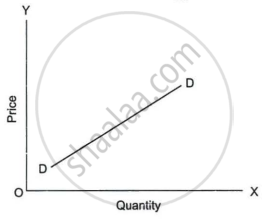Advertisements
Advertisements
Question
The demand curve is generally ______.
Options
Downward sloping
Upward sloping
Horizontal parallel to the X-axis
Vertical parallel to the Y-axis
Solution
The demand curve is generally downward sloping.
Explanation:
The demand curve is generally downward-sloping. This reflects the law of demand, which states that, all else being equal, as the price of a good decreases, the quantity demanded increases, and vice versa. This negative relationship between price and quantity demanded results in a downward-sloping demand curve.
APPEARS IN
RELATED QUESTIONS
The diagram given below shows the original demand curve (DD) for good X, which is a complement of good Y:
If there is a rise in the price of good Y, which demand curve for good X is relevant?

In the following diagram, the demand curve is upward sloping. Under what kind of goods is it possible?

Differentiate between individual demand schedule and market demand schedule.
Using hypothetical data show a market demand schedule.
State the impact of the following changes on the demand curve of a commodity:
A rise in the price of the commodity
State the impact of the following changes on the demand curve of a commodity:
Increase in the supply of a substitute commodity
State the impact of the following changes on the demand curve of a commodity:
Increase in the price of a complementary commodity
Shyam, Sita, Renu, Ahmed and John are five consumers of apples. Their demand for apples is given below. Derive the market demand schedule for apples.
| Price per Kg (in ₹) | Quantity Demanded (Apples) in Kg. | ||||
| Shyam | Sita | Renu | Ahmed | John | |
| 25.00 | 16 | 15 | 12 | 14 | 18 |
| 30.00 | 12 | 11 | 10 | 8 | 15 |
| 35.00 | 10 | 9 | 8 | 6 | 12 |
| 40.00 | 8 | 6 | 4 | 2 | 8 |
How is the market demand curve derived from the individual demand curves?
Define a market demand schedule.
